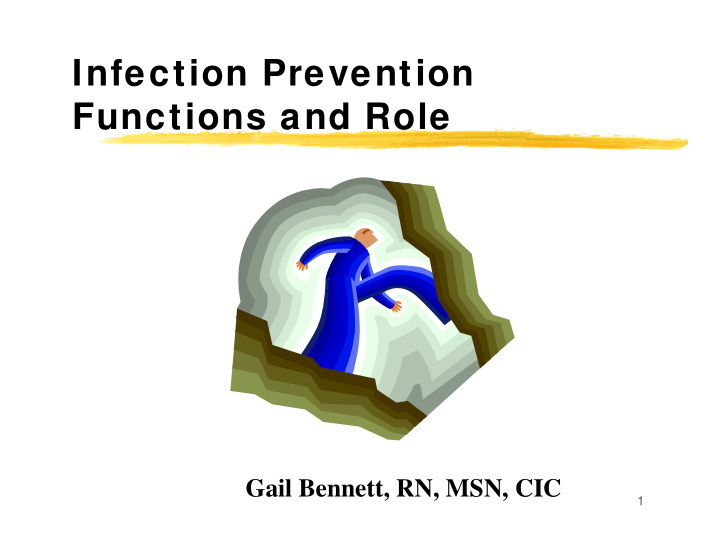



Infection Prevention Functions and Role Gail Bennett, RN, MSN, CIC 1
How do I know if w e have a comprehensive infection prevention program? 2 2
Infection Prevention Activities Surveillance Education Consultation Performance Improvement (Compliance) Policies and Procedures Committee Management Outbreak Investigation 3
Surveillance of Infections 2 nd presentation 4
Education Orientation Annual, mandatory programs One on one teaching 5
Orientation (Examples) Pamphlets TB Fact Sheet Hepatitis B Vaccine Fact Sheet BBP training: May use a variety of methods Training must be done BEFORE we offer vaccine Qualified person must be available to answer questions 6
Annual Mandatory IC Training Must include bloodborne pathogens and TB 100% attendance required by OSHA 7
Scenario OSHA walks in your facility in 2011 and starts requesting documents “I need your documentation of all employees (FT and PT) for 2009 and proof that they all completed the 2009 mandatory bloodborne pathogens training program.” “How quickly can you have that ready?” 8
Documenting 100% attendance at annual, mandatory IC program Recommendation: if no software program to monitor attendance, print a list of all associates working with the facility at the time of the training. Have each associate sign in beside their name Review list for those associates who have not signed beside their names to know who needs to attend a make-up course. Maintain the records in a safe place. 9
One on One Teaching May provide during compliance or surveillance rounds Anytime non-optimal technique is observed Provide privacy for staff when counseling is done Document in your records 10
Consultation – You’re the Consultant Use resources to get answers! Web sites Professional Guidelines Textbooks Guidelines/policy manuals State IP groups APIC chapter Other 11
Resource Control of Communicable Diseases Manual, 18th edition, 2004. Edited by David Heymann ISBN 0-87554-242-X/PC $33.00, 623 pages Excellent, inexpensive IC resource! 12
APIC Textbook The APIC Text Online is a subscription-based resource and is available to APIC members for $149/year and non-members for $199/year. To access the APIC Text Online, visit http://text.apic.org 13
Centers for Disease Control and Prevention (www.cdc.gov) Association for Professionals in Infection Control and Epidemiology (www.apic.org) Infection Control certification (www.cbic.org) ICP Associates (www.icpassociates.com) 15
16
17
18 18
19
20
Quality Assurance/Performance Improvement Performance Improvement Program – have an active IC PI program Compliance Monitoring 21
22
23
State Reporting Requirements North Dakota reportable diseases http://www.ndhealth.gov/disease/Docume nts/ReportableConditions.pdf 24
25
Policies and Procedures Have P&Ps based on regulations, standards, and current guidelines Enforce your policies Monitor for compliance Review periodically Make changes as needed 26
Committee Management: Infection Control Meet on a regular schedule Make the meeting convenient Start and end on time Have a well prepared written agenda Prepare concise, accurate minutes that show problem-solving for IC 27
Outbreaks (w ill discuss in detail tomorrow ) Outbreak (excess cases over normal) Inpatient facilities will usually recognize their outbreaks Ambulatory care: outbreaks will likely be identified by people outside your center 28 28
Outbreak Investigation Know when and where to get help! Clearly document your investigation. 29
Recent outbreaks relating to Ambulatory Care Outbreaks of Hepatitis C in Healthcare Settings Publications Transmission of Hepatitis B and C Viruses in Outpatient Settings --- New York, Oklahoma, and Nebraska, 2000—2002. Viral Hepatitis Transmission in Ambulatory Health Care Settings.* Spotlight: Viral Hepatitis Transmission in Ambulatory Health Care Settings An Outbreak of Hepatitis C Virus Infections Among Outpatients at a Hematology/Oncology Clinic.* A large nosocomial outbreak of hepatitis C and hepatitis B among patients receiving pain remediation treatments.* 30 30
Recent outbreaks relating to Ambulatory Care ….and an important message to all healthcare organizations! Failure to adhere to basic principles of aseptic technique for the preparation and administration of parenteral medications Unsafe practices Syringe reuse between patients during parenteral med administration to multiple patients Contamination of medication vials or IV bags by accessing them with a used syringe and/or needle Failure to follow basic injection safety practices when preparing and administering parenteral meds to multiple patients Inappropriate use of fingerstick devices and glucometer equipment between patients APIC Position Paper: Safe Injection, Infusion, and Medication Vial Practices in Healthcare , 2009 31 31 www.apic.org
32
Sentinel events A single occurrence which requires immediate action 33
Problem-solving Assessing Planning Implementing Evaluating 34
Questions?? 35
Recommend
More recommend